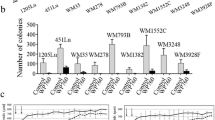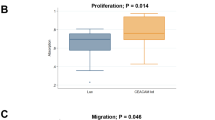Abstract
The role of the ABCB8 gene in human cells is poorly understood, although it has been suggested to be involved in multidrug resistance in some types of cancers (e.g., melanomas). In this study, the main mechanism of transcriptional regulation of the ABCB8 gene was characterized. EMSA and ChIP assays revealed that the transcription factor Sp1 binds to the ABCB8 core promoter region, and Sp1 consensus elements were crucial for promoter activity in a luciferase reporter gene assay. Mithramycin A, an inhibitor of Sp1 binding, downregulated the expression of ABCB8 (and other ABC genes) in a concentration-dependent manner and sensitized a melanoma cell line to doxorubicin treatment. These findings may have therapeutic applications in at least a subset of melanoma patients.







Similar content being viewed by others
References
Ardehali H, Chen Z, Ko Y, Mejia-Alvarez R, Marban E (2004) Multiprotein complex containing succinate dehydrogenase confers mitochondrial ATP-sensitive K+ channel activity. Proc Natl Acad Sci USA 101:11880–11885
Ardehali H, O’Rourke B, Marban E (2005) Cardioprotective role of the mitochondrial ATP-binding cassette protein 1. Circ Res 97:740–742
Bajetta E, Del Vecchio M, Bernard-Marty C, Vitali M, Buzzoni R, Rixe O, Nova P, Aglione S, Taillibert S, Khayat D (2002) Metastatic melanoma: chemotherapy. Semin Oncol 29:427–445
Bark H, Choi CH (2010) PSC833, cyclosporine analogue, downregulates MDR1 expression by activating JNK/c-Jun/AP-1 and suppressing NF-kappaB. Cancer Chemother Pharmacol 65:1131–1136
Blume SW, Snyder RC, Ray R, Thomas S, Koller CA, Miller DM (1991) Mithramycin inhibits SP1 binding and selectively inhibits transcriptional activity of the dihydrofolate reductase gene in vitro and in vivo. J Clin Invest 88:1613–1621
Burke MA, Ardehali H (2007) Mitochondrial ATP-binding cassette proteins. Transl Res 150:73–80
Cartharius K, Frech K, Grote K, Klocke B, Haltmeier M, Klingenhoff A, Frisch M, Bayerlein M, Werner T (2005) MatInspector and beyond: promoter analysis based on transcription factor binding sites. Bioinformatics 21:2933–2942
Chen KG, Valencia JC, Gillet JP, Hearing VJ, Gottesman MM (2009) Involvement of ABC transporters in melanogenesis and the development of multidrug resistance of melanoma. Pigment Cell Melanoma Res 22:740–749
Chiefari E, Brunetti A, Arturi F, Bidart JM, Russo D, Schlumberger M, Filetti S (2002) Increased expression of AP2 and Sp1 transcription factors in human thyroid tumors: a role in NIS expression regulation? BMC Cancer 2:35
Dabrowska M, Sirotnak FM (2004) Regulation of transcription of the human MRP7 gene. Characteristics of the basal promoter and identification of tumor-derived transcripts encoding additional 5′ end heterogeneity. Gene 341:129–139
Dignam JD, Lebovitz RM, Roeder RG (1983) Accurate transcription initiation by RNA polymerase II in a soluble extract from isolated mammalian nuclei. Nucleic Acids Res 11:1475–1489
Elliott AM, Al-Hajj MA (2009) ABCB8 mediates doxorubicin resistance in melanoma cells by protecting the mitochondrial genome. Mol Cancer Res 7:79–87
Essafi-Benkhadir K, Grosso S, Puissant A, Robert G, Essafi M, Deckert M, Chamorey E, Dassonville O, Milano G, Auberger P, Pages G (2009) Dual role of Sp3 transcription factor as an inducer of apoptosis and a marker of tumour aggressiveness. PLoS One 4:e4478
Ghayor C, Chadjichristos C, Herrouin JF, Ala-Kokko L, Suske G, Pujol JP, Galera P (2001) Sp3 represses the Sp1-mediated transactivation of the human COL2A1 gene in primary and de-differentiated chondrocytes. J Biol Chem 276:36881–36895
Gillet JP, Efferth T, Steinbach D, Hamels J, de Longueville F, Bertholet V, Remacle J (2004) Microarray-based detection of multidrug resistance in human tumor cells by expression profiling of ATP-binding cassette transporter genes. Cancer Res 64:8987–8993
Heicklen-Klein A, Ginzburg I (2000) Tau promoter confers neuronal specificity and binds Sp1 and AP-2. J Neurochem 75:1408–1418
Herget M, Tampe R (2007) Intracellular peptide transporters in human–compartmentalization of the “peptidome”. Pflugers Arch 453:591–600
Jia Z, Zhang J, Wei D, Wang L, Yuan P, Le X, Li Q, Yao J, Xie K (2007) Molecular basis of the synergistic antiangiogenic activity of bevacizumab and mithramycin A. Cancer Res 67:4878–4885
Jia Z, Gao Y, Wang L, Li Q, Zhang J, Le X, Wei D, Yao JC, Chang DZ, Huang S, Xie K (2010) Combined treatment of pancreatic cancer with mithramycin A and tolfenamic acid promotes Sp1 degradation and synergistic antitumor activity. Cancer Res 70:1111–1119
Kaminski WE, Piehler A, Schmitz G (2000) Genomic organization of the human cholesterol-responsive ABC transporter ABCA7: tandem linkage with the minor histocompatibility antigen HA-1 gene. Biochem Biophys Res Commun 278:782–789
Kim SN, Kim NH, Lee W, Seo DW, Kim YK (2009) Histone deacetylase inhibitor induction of P-glycoprotein transcription requires both histone deacetylase 1 dissociation and recruitment of CAAT/enhancer binding protein beta and pCAF to the promoter region. Mol Cancer Res 7:735–744
Liu F, Pore N, Kim M, Voong KR, Dowling M, Maity A, Kao GD (2006) Regulation of histone deacetylase 4 expression by the SP family of transcription factors. Mol Biol Cell 17:585–597
Mealey J Jr, Chen TT, Pedlow E (1970) Brain tumor chemotherapy with mithramycin and vincristine. Cancer 26:360–367
Pulaski L, Kania K, Ratajewski M, Uchiumi T, Kuwano M, Bartosz G (2005) Differential regulation of the human MRP2 and MRP3 gene expression by glucocorticoids. J Steroid Biochem Mol Biol 96:229–234
Ratajewski M, Van de Ven WJ, Bartosz G, Pulaski L (2008) The human pseudoxanthoma elasticum gene ABCC6 is transcriptionally regulated by PLAG family transcription factors. Hum Genet 124:451–463
Safe S, Abdelrahim M (2005) Sp transcription factor family and its role in cancer. Eur J Cancer 41:2438–2448
Saffer JD, Jackson SP, Annarella MB (1991) Developmental expression of Sp1 in the mouse. Mol Cell Biol 11:2189–2199
Scarpulla RC (2002) Nuclear activators and coactivators in mammalian mitochondrial biogenesis. Biochim Biophys Acta 1576:1–14
Scotto KW (2003) Transcriptional regulation of ABC drug transporters. Oncogene 22:7496–7511
Scotto KW, Egan DA (1998) Transcriptional regulation of MDR genes. Cytotechnology 27:257–269
Slavik M, Carter SK (1975) Chromomycin A3, mithramycin, and olivomycin: antitumor antibiotics of related structure. Adv Pharmacol Chemother 12:1–30
Summers KM, Bokil NJ, Baisden JM, West MJ, Sweet MJ, Raggatt LJ, Hume DA (2009) Experimental and bioinformatic characterisation of the promoter region of the Marfan syndrome gene, FBN1. Genomics 94:233–240
Szakacs G, Annereau JP, Lababidi S, Shankavaram U, Arciello A, Bussey KJ, Reinhold W, Guo Y, Kruh GD, Reimers M, Weinstein JN, Gottesman MM (2004) Predicting drug sensitivity and resistance: profiling ABC transporter genes in cancer cells. Cancer Cell 6:129–137
Takai D, Jones PA (2003) The CpG island searcher: a new WWW resource. In Silico Biol 3:235–240
Tang L, Bergevoet SM, Franssen LE, de Witte T, Jansen JH, Raymakers RA, van der Reijden BA (2009) Exclusion of ABCB8 and ABCB10 as cancer candidate genes in acute myeloid leukemia. Leukemia 23:1000–1002
Thangasamy A, Rogge J, Ammanamanchi S (2008) Regulation of RON tyrosine kinase-mediated invasion of breast cancer cells. J Biol Chem 283:5335–5343
Tintrup H, Fischer M, Betz H, Kuhse J (2001) Exonic Sp1 sites are required for neural-specific expression of the glycine receptor beta subunit gene. Biochem J 355:179–187
Valin A, Cook JD, Ross S, Saklad CL, Gill G (2009) Sp1 and Sp3 regulate transcription of the cyclin-dependent kinase 5 regulatory subunit 2 (p39) promoter in neuronal cells. Biochim Biophys Acta 1789:204–211
Vandesompele J, De Preter K, Pattyn F, Poppe B, Van Roy N, De Paepe A, Speleman F (2002). Accurate normalization of real-time quantitative RT-PCR data by geometric averaging of multiple internal control genes. Genome Biol 3: RESEARCH0034
Wang L, Wei D, Huang S, Peng Z, Le X, Wu TT, Yao J, Ajani J, Xie K (2003) Transcription factor Sp1 expression is a significant predictor of survival in human gastric cancer. Clin Cancer Res 9:6371–6380
Wang L, Guan X, Zhang J, Jia Z, Wei D, Li Q, Yao J, Xie K (2008) Targeted inhibition of Sp1-mediated transcription for antiangiogenic therapy of metastatic human gastric cancer in orthotopic nude mouse models. Int J Oncol 33:161–167
Wei D, Wang L, He Y, Xiong HQ, Abbruzzese JL, Xie K (2004) Celecoxib inhibits vascular endothelial growth factor expression in and reduces angiogenesis and metastasis of human pancreatic cancer via suppression of Sp1 transcription factor activity. Cancer Res 64:2030–2038
Yuan P, Wang L, Wei D, Zhang J, Jia Z, Li Q, Le X, Wang H, Yao J, Xie K (2007) Therapeutic inhibition of Sp1 expression in growing tumors by mithramycin a correlates directly with potent antiangiogenic effects on human pancreatic cancer. Cancer 110:2682–2690
Zannetti A, Del Vecchio S, Carriero MV, Fonti R, Franco P, Botti G, D’Aiuto G, Stoppelli MP, Salvatore M (2000) Coordinate up-regulation of Sp1 DNA-binding activity and urokinase receptor expression in breast carcinoma. Cancer Res 60:1546–1551
Zhou SF (2008) Structure, function and regulation of P-glycoprotein and its clinical relevance in drug disposition. Xenobiotica 38:802–832
Zhu Q, Center MS (1996) Evidence that SP1 modulates transcriptional activity of the multidrug resistance-associated protein gene. DNA Cell Biol 15:105–111
Acknowledgments
We would like to thank Dr. Lukasz Pulaski for helpful discussions. This work was partially supported by the Project PL0107 “Cellular biosensors for automated monitoring of environmental pollution,” by the START Programme of the Foundation for Polish Science, and by statutory funds from the Institute of Medical Biology.
Author information
Authors and Affiliations
Corresponding author
Additional information
Communicated by S. Hohmann.
Rights and permissions
About this article
Cite this article
Sachrajda, I., Ratajewski, M. Mithramycin A suppresses expression of the human melanoma-associated gene ABCB8 . Mol Genet Genomics 285, 57–65 (2011). https://doi.org/10.1007/s00438-010-0586-8
Received:
Accepted:
Published:
Issue Date:
DOI: https://doi.org/10.1007/s00438-010-0586-8




